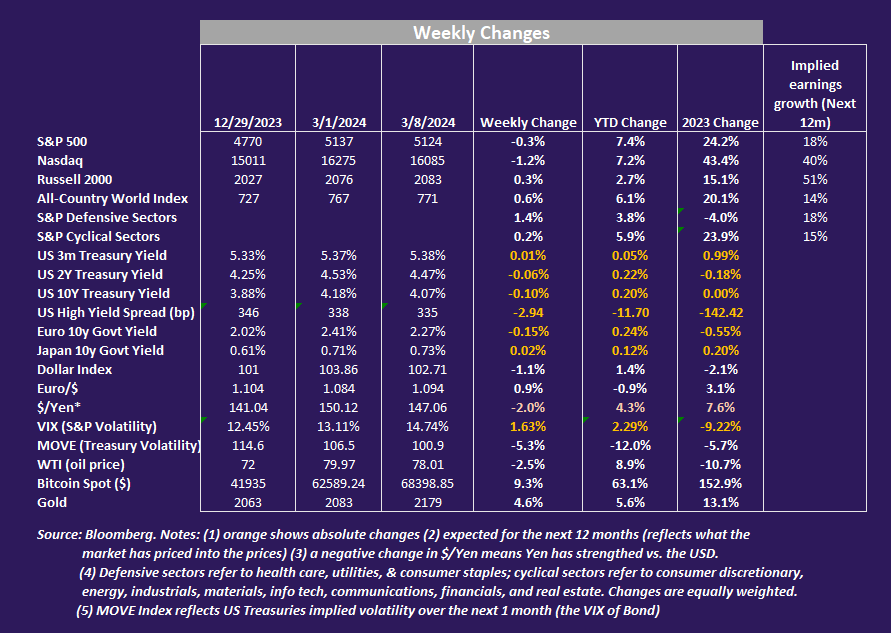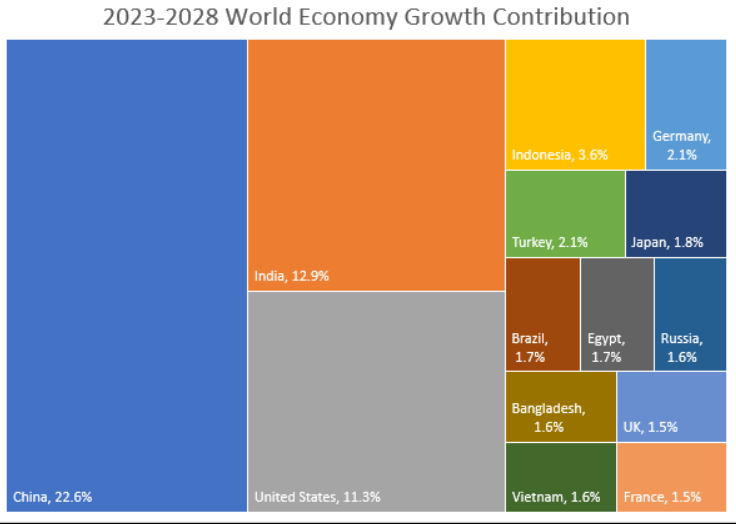Weekly Good Reads: 5-1-1
Fed's Testimony, Global Real GDP Forecasts, China's Economy, Scam, Women, Cashless Society
Welcome to Weekly Good Reads 5-1-1 by Marianne O, a 25-year investment practitioner and the author of
on investing, economy, and wellness in an intuitive voice. All the Weeklies are here, and here is the index of charts and terms. You can easily subscribe to my newsletter by clicking below.Check out my conversations with Female Fund Managers and Investors.
Thank you so much for your support🙏.
Market and Data Comments
The market seems to hang its hat on what Fed Chairman Powell said in his testimony to Congress this week that the Fed is “not far from gaining competence that it will be appropriate to begin dialling back the level of restrictions.” At the same time, the Fed supports a re-proposal of the Basel III banking framework so big banks will not need to raise even more capital (see Econ/Invest. #1 and #2).
A robust US labour market (+275K increase in February nonfarm payrolls but a -170K revision downwards for the previous 2 months) with slower-than-expected wage growth at 3.8% m-on-m annualized and an uptick in the unemployment rate to 3.9% point to an economy that is strong but not reaccelerating and is still dis-inflating. The Atlanta Fed’s GDPNow tracks (as of March 7) a Q1 real GDP of 2.5%.
In contrast, Europe and the UK seem to struggle to take off given the pressure from high interest rates, energy costs, wage demand, and slower China demand. The ECB revised its projections for inflation and growth downwards this year, which may signal a willingness to cut as soon as April before the Fed does.
Japan on the other hand is facing the largest wage demand in 30 years. The “Shunto” wage negotiation will start next week with the union demanding on average a wage rise of 5.85% (4.3% is base pay). Final expectations would be around a 4.5% wage hike this year (much higher than 3.58% last year), pointing to the pressure for the Bank of Japan to exit negative rates in March/April.
The US S&P 500 index retreated by 0.3% while the defensive stock sectors led by utilities outperformed the growth/cyclical sectors (technology, communications, consumer discretionary). Ex-US developed markets did better relatively. Overall, bond yield rallied in the US and Europe but rose in Japan.
Bitcoin continued to surge another 9.3% this week to over $68,000. However before one jumps onto the bandwagon, investors can ponder upon this Morningstar research: “…adding 2% of Bitcoin to a hypothetical costless 60/40 portfolio changed its return profile by almost as much as adding a 10% stake in stocks. Adding 5% resulted in a risk profile more similar to a portfolio made up of 90% stocks and 10% bonds.”
In the top chart, Barclays shows the 2023 vs. 2024 GDP forecasts in global economies and a picture of a global soft landing. While a negative real GDP growth rate is expected in Argentina, countries including India and Indonesia will see real GDP growth at or above 5% (India close to 7%), and China and Saudi Arabia between 4.5-5%.
Last but not least, at China announced at the National People’s Congress (NPC) meeting a 5% real GDP growth target for 2024; however, stimulus support looks insufficient and there is little rebalancing effort towards raising consumption away from investments. According to Morgan Stanley’s China economist:
The government remains focused on upgrading supply chain, promoting “disruptive innovation” and self-sufficiency, as well as improving basic scientific education & research – they are the top key tasks for 2024. The central government allocated Rmb370bn in support for technology development (up 10% from 2023). On industrial policy, NPC mentioned: (1) the automation, digitalization and greening of supply chains; (2) further improving IoT and NEV industries; and (3) nurturing new growth drivers such as biotech, advanced materials, and low-altitude aircraft. In comparison, economic rebalancing efforts remained relatively slow.
China’s February CPI did rise 0.7% yoy after 6 months of consecutive yoy decline due to the Chinese New Year consumption boost. However, PPI still declined 2.7% yoy.
Next week we will monitor the US February CPI (and core inflation) on Tuesday, February retail sales and February PPI on Thursday, February industrial production on Friday, the Euro Area February industrial production on Wednesday and various European countries’ final February inflation rates as well as Japan’s wage negotiations.

Economy and Investments (Links):
Jerome Powell Says Fed on Track to Cut Rates This Year (WSJ via Archive)
A`No-Landing’ US Economy Will Get the Rate Cuts Markets Crave (Bloomberg via Archive)
What’s Wrong With China’s Economy? Can It Be Fixed? (Bloomberg via Archive) - this is a terrific summary of China’s economic significance and challenges, which include an ailing property market (lowering land revenue), shaky consumer confidence (as prices declined), hidden debt at the local government level, and the US technology exports ban to China.
Finance/Wealth (Link):
The Day I Put $50,000 in a Shoe Box and Handed It to a Stranger. I never thought I was the kind of person to fall for a scam (The New York Magazine) - a crazy situation but with great lessons.
We need to show that, when we make porridge for you when you have a fever, it’s not because we are wives or mothers, but because of our personal love and responsibility for you. And we need to teach our sons that men, too, can make porridge for someone who needs help. We need to make it normal for men, too, to take care of themselves and help one another.
+ How Investors Get Risk Wrong (The Economist)
Wellness/Idea (Link)
Is Coffee Bad For Your Heart (Arnold Schwarzenegger)
+ 👩💻 In celebration of Women's History Month, here are some great articles I read this month:
Mieko Kawakami On How Men Can Make the World Better For Women (The Economist or via Archive)
We need to show that, when we make porridge for you when you have a fever, it’s not because we are wives or mothers, but because of our personal love and responsibility for you. And we need to teach our sons that men, too, can make porridge for someone who needs help. We need to make it normal for men, too, to take care of themselves and help one another.~ Mieko Kawakami (acclaimed Japanese writer and poet).
Author Talks: Grace Puma Shares How Working Women Can Shatter the Glass Ceiling (McKinsey)
Are Women Our Economy’s Superheros? (SheMoney by Jacki Zehner)
The Economic Power of Gender Equality (Project Syndicate or via Archive)

Policymakers must also value, recognize, and account for the vital contribution women make to economies worldwide through paid and unpaid care work. Women spend around three times more time on unpaid care work than men and if these activities were assigned a monetary value they would account for more than 40 per cent of GDP.
~ United Nations
One Chart You Should Not Miss: Economic Growth Contribution by Countries
The International Monetary Fund (IMF) recently released its economic growth projections. Once again, China is the top growth contributor in the next 5 years, followed by India and the United States. China’s growth matters as Bloomberg summarized below (see Econ/Invest. #3 above):
China’s expansion is a driver of global trade, and mineral-exporting countries such as Brazil and Australia are particularly sensitive to the ups and downs of Chinese infrastructure and property investment. Prices of metals such as iron ore and copper were volatile last year as demand in the world’s biggest market fell short of expectations. The slump is hitting exporters of high-tech goods especially, with shipments from South Korea and Taiwan dropping every month last year. Waning consumer confidence is also eating into the bottom lines of many big multinational brands, from Starbucks Corp. to L’Oreal SA.
One Term To Know: Checkless (Cashless) Society
A “Checkless Society” is one where all financial transactions will be done electronically, eliminating the usage of coins, paper bills, and cheques. Benefits of a “Checkless Society” include faster processing times, overhead costs reduction by reducing the need for human personnel, and greater regulatory oversight of transactions.
In the US, while not as advanced in countries like China, noncash payments value increased by 9.5% from 2018 to 2021 according to the Fed led by ACH transfers, which accounted for more than 90% of the rise in noncash payments value from 2018 to 2021 and are 72% of total non-cash payments value in 2021.
My recent trip to China confirms the convenience of using apps and electronic payments in local souvenir stores, restaurants, and food vendors. Street food vendors preferred us to pay by “WeChat Pay” or “Alipay” by scanning their QR codes. My credit cards (AMEX or Visa) can be linked to WeChat Pay or Alipay. [My AMEX payments do not always go through while Visa works without problems with WeChat Pay.]
Please do not hesitate to get in touch if you have any questions!
Check out also my Conversations with Female Investors and other changemakers.
(P.S. I am so happy Victory Capital links on LinkedIn my conversation with U-Wen Kok on International Women’s Day 2024!)
If you like this Weekly, please share it with your friends or subscribe to my newsletter🤝.






